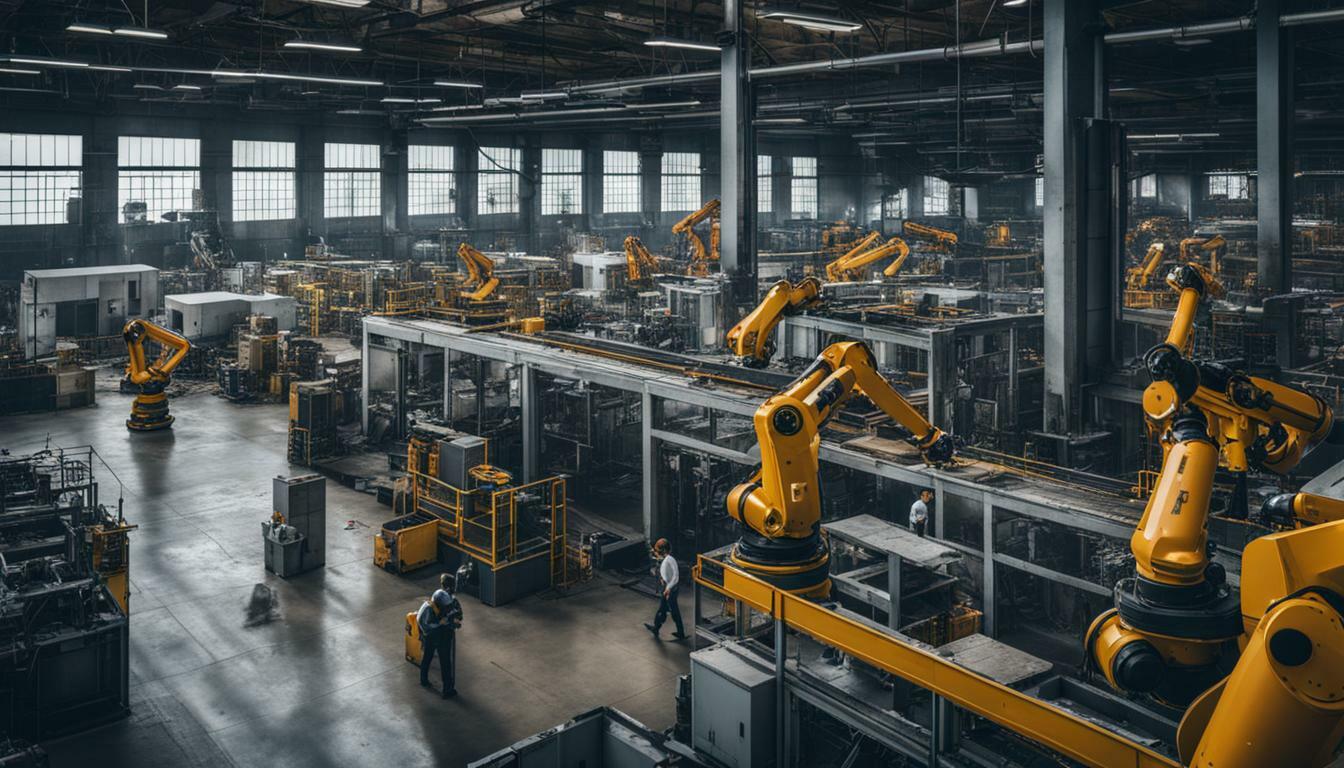AI job displacement has become a significant concern in the U.S. labor markets, with the increasing adoption of artificial intelligence (AI) and automation technologies.
Advances in AI and automation have led to predictions of high levels of job automation and significant changes in the nature of work. It is expected that the impact of AI on jobs and employment will vary across different industries and geographic regions.
- The impact of AI on jobs and employment is expected to vary across different industries and geographic regions.
- Governments can take steps to mitigate the negative effects of automation by conducting research, implementing targeted strategies, and adapting education systems.
- Welfare programs such as unemployment benefits, wage insurance, and job training can help workers affected by job displacement.
- An egalitarian society with a robust welfare state is essential to ensure stability and minimum living standards for workers.
- Policymakers must balance progress and innovation in AI technology with safeguards for workers and consumers.
The Impact of AI on Jobs and Employment: Predictions and Variations
Advances in artificial intelligence (AI) and automation have raised concerns about job displacement. Numerous studies have indicated that these advancements will lead to significant changes in the nature of work, causing job losses and disruptions in various sectors. The impact of AI on jobs and employment is expected to vary across different industries and geographic regions.
In the United Kingdom, for example, research suggests that 30% of jobs are at high risk of automation, with higher levels predicted in former industrial areas. This indicates that certain sectors and regions are more vulnerable to AI-related job losses than others.
To gain a better understanding of the implications of AI on employment, wages, and labor market opportunities, ongoing studies are being conducted in both the European Union and the United States. These studies aim to provide insights into how AI will reshape workforces and potentially disrupt traditional employment patterns.
As the future of work becomes increasingly automated, policymakers face the challenge of balancing progress and innovation with safeguards for workers and consumers. It is crucial to implement policies and regulations that protect workers from the negative impacts of AI while still encouraging technological advancements.
| Impact of AI on Jobs and Employment | Predictions and Variations |
|---|---|
| Varying Levels of Automation | Not all industries and regions will be equally affected by AI job losses. Some sectors and former industrial areas are more vulnerable to automation. |
| Ongoing Studies | Research is being conducted in the European Union and the United States to understand the implications of AI on employment, wages, and labor market opportunities. |
| Policy Dilemma | Policymakers face the challenge of striking a balance between progress and innovation in AI technology while implementing safeguards for workers and consumers. |
While AI has the potential to automate routine and non-routine tasks, it is important to note that it also presents opportunities for new jobs and industries. The future job market will require a workforce equipped with the necessary skills to thrive in an AI-driven economy.
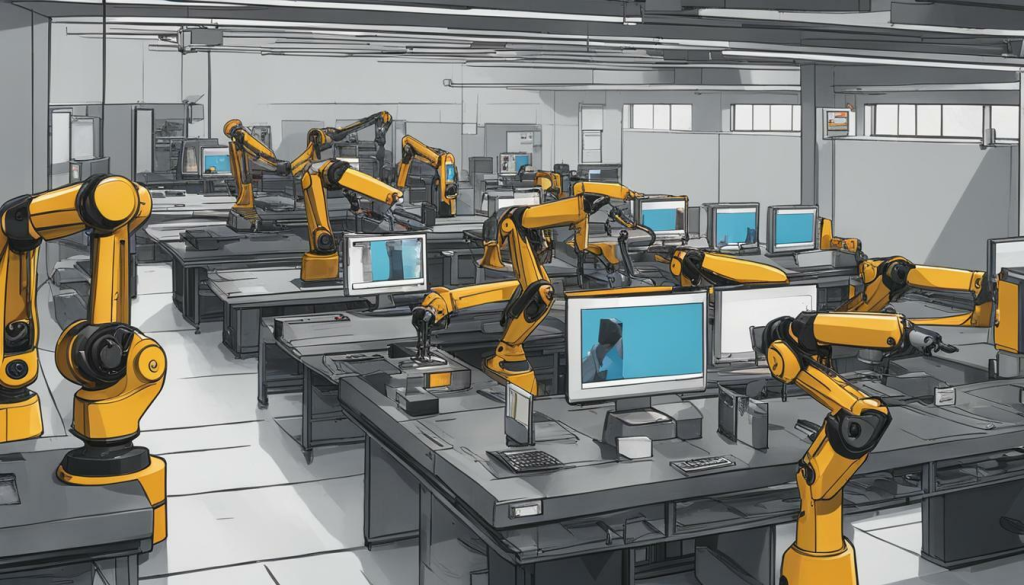
As we navigate the evolving landscape of AI and automation, it is essential to consider the potential impacts on employment and take proactive measures to support workers and ensure stability in the job market.
Mitigating the Negative Effects of Automation: Government Strategies
Governments can play a crucial role in minimizing the adverse effects of automation by adopting proactive measures to address job displacement and equip workers with the necessary skills for the future. As advances in artificial intelligence (AI) and automation continue to reshape the workforce, it is imperative for policymakers to prioritize strategies that balance progress and innovation with safeguards for workers and consumers.
One key strategy is for governments to conduct comprehensive research to understand the potential impact of automation in different industries and regions. This research can help policymakers identify vulnerable sectors and implement targeted strategies to mitigate the negative effects of job displacement. By focusing on areas most at risk, governments can allocate resources and support systems effectively.
Additionally, governments must prioritize the adaptation of education systems to equip the workforce with the skills needed in an AI-driven economy. By investing in job training and reskilling programs, governments can ensure that workers are equipped with the necessary expertise to thrive in a changing job market. Education subsidies and career counseling services can further support workers in navigating the transition.
| Government Strategies to Mitigate Job Displacement | Examples |
|---|---|
| Conducting research and identifying vulnerable sectors | Investing in automation impact studies and sector-specific analysis |
| Implementing targeted strategies | Creating innovation hubs and supporting emerging industries |
| Adapting education systems | Offering free or subsidized training programs and vocational courses |
| Exploring alternative income and taxation models | Considering universal basic income and fair taxation policies |
Lastly, exploring alternative income and taxation models can also help mitigate the negative impacts of automation. Governments can consider policies such as universal basic income or fair taxation models that redistribute wealth and ensure economic stability for all. These measures can provide a safety net and guarantee minimum living standards, especially for those most affected by job displacement.
By taking these proactive measures, governments can navigate the challenges presented by automation and create a more resilient workforce. It is essential to strike a balance between harnessing the potential of AI and automation and safeguarding the livelihoods of workers to ensure a prosperous and inclusive future.
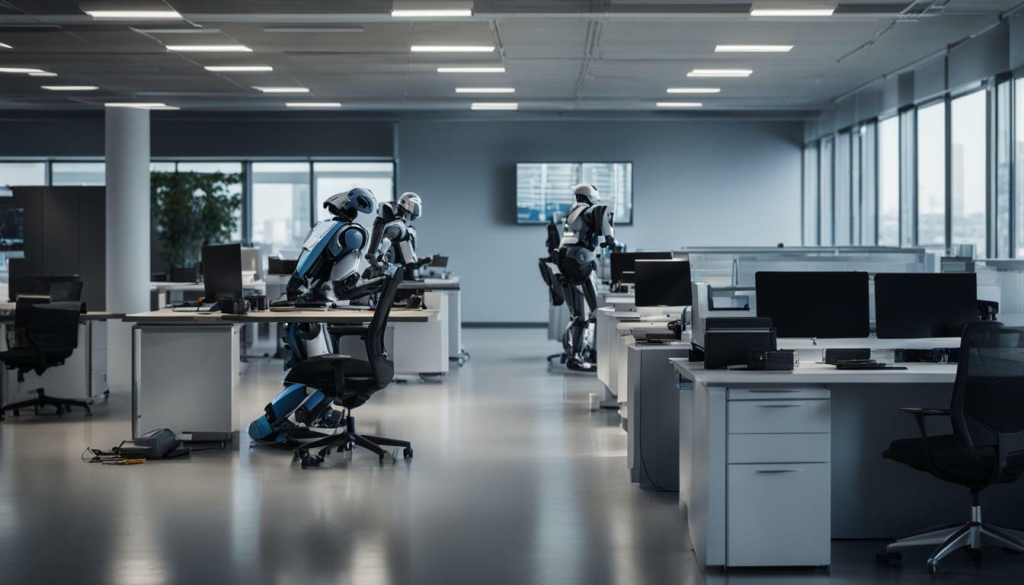
AI Job Displacement: Supporting Workers Affected by AI Automation
To ensure the well-being of workers impacted by job displacement, comprehensive welfare programs and educational initiatives are essential to facilitate their transition into new employment opportunities. By providing a safety net and equipping individuals with the necessary skills, we can mitigate the negative effects of job automation and create a more resilient workforce.
Welfare programs play a crucial role in supporting workers during periods of job displacement. Unemployment benefits offer temporary financial assistance, ensuring individuals have a stable income while they search for new employment. These benefits not only provide financial support but also help to maintain a sense of dignity and security during uncertain times.

Additionally, wage insurance programs can bridge the income gap for workers who secure new jobs with lower pay. This helps to alleviate the potential financial strain caused by job displacement and encourages individuals to pursue alternative career paths without fear of significant income loss.
Investing in job training and reskilling programs is also vital in preparing workers for the future of work. By providing access to education subsidies and career counseling services, individuals can acquire new skills and gain insights into emerging industries and employment opportunities. This proactive approach equips workers with the tools they need for successful career transitions and minimizes the disruption caused by job displacement.
In this era of rapid technological advancement, welfare programs and education play a crucial role in empowering workers impacted by job displacement. By fostering a supportive environment and prioritizing individuals’ well-being, we can ensure the continued prosperity of our workforce and create a future where technology and human labor coexist harmoniously.
Table 1: Welfare programs for supporting workers affected by job displacement
| Program | Description |
|---|---|
| Unemployment Benefits | Temporary financial assistance for individuals who lose their jobs |
| Wage Insurance | Financial support for workers who secure new jobs with lower pay |
| Job Training and Reskilling | Programs aimed at equipping workers with new skills and knowledge |
| Education Subsidies | Financial support for individuals pursuing further education or training |
| Career Counseling | Guidance and support in navigating career transitions |
The Need for Egalitarian Societies: Ensuring Stability and Minimum Living Standards
As technology continues to replace jobs, it becomes imperative for societies to prioritize equitable distribution of wealth and resources, ensuring that no individual is left behind in the changing landscape of work.
The impact of artificial intelligence (AI) on the job market raises concerns about job loss and unemployment rates. Studies have predicted significant changes in the nature of work, with high levels of job automation anticipated in various industries and geographic regions. In the UK, for example, 30% of jobs are at high risk of automation, with former industrial areas expected to face even higher levels of automation.
To mitigate the negative effects of automation, governments play a vital role in implementing strategies and policies. Conducting research on the impact of AI on employment, wages, and labor market opportunities helps policymakers make informed decisions. Targeted strategies can be designed to support workers affected by job displacement, including job training and reskilling programs. Adapting education systems is crucial to equip the workforce with the skills needed to thrive in the era of automation.
Welfare programs also play a pivotal role in supporting workers during periods of job displacement. Unemployment benefits, wage insurance, education subsidies, and career counseling are essential in providing financial stability and opportunities for career growth. These programs ensure that individuals have access to resources and support as they navigate through the changing job market.
Supporting Workers Affected by Job Displacement: Welfare Programs
Welfare programs such as unemployment benefits provide temporary financial assistance to individuals who have lost their jobs due to automation. This not only helps them meet their basic needs but also gives them time to find suitable employment or participate in training programs. Wage insurance programs can assist workers who experience wage cuts after being reemployed in lower-paying jobs. By supplementing their income, this program aims to provide a safety net during the transition period.
Education subsidies and job training initiatives are crucial for equipping workers with the skills necessary to adapt to changing job requirements. These programs help individuals acquire new knowledge and competencies, enhancing their employability in the rapidly evolving job market. Additionally, career counseling services can provide guidance and support, assisting workers in making informed decisions about their career paths.
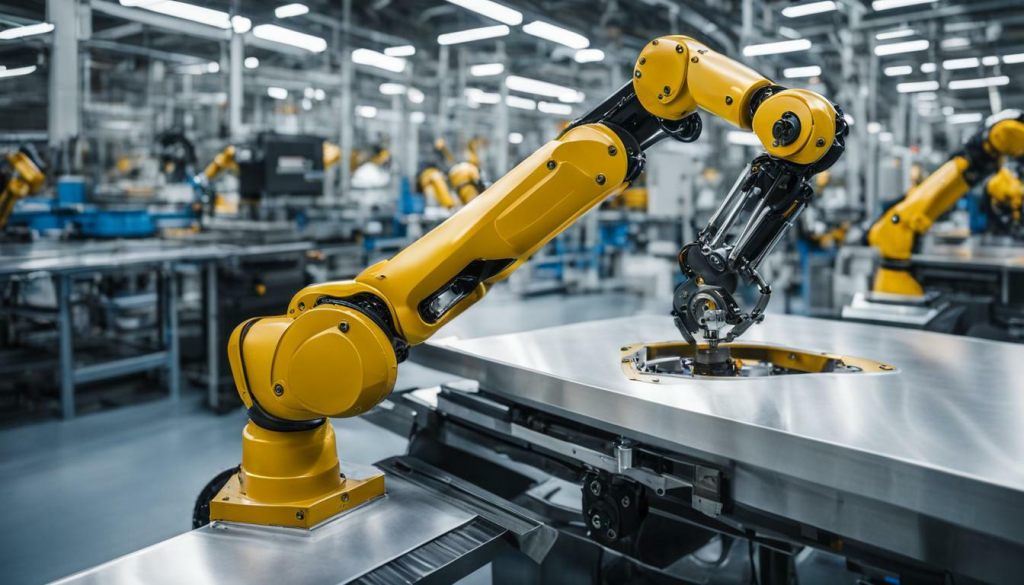
The Importance of a Robust Welfare State
Building a more egalitarian society with a robust welfare state is essential to ensure stability and minimum living standards for workers affected by job displacement. As technology continues to reshape jobs, it is crucial to prioritize the well-being of individuals and promote social cohesion. By implementing comprehensive welfare programs and support systems, societies can mitigate the negative impact of automation and foster a sense of security and inclusivity for all.
It is important for policymakers and stakeholders to strike a balance between progress, innovation, and worker safeguards. While AI and automation offer tremendous opportunities for growth and efficiency, it is essential to consider the potential risks and challenges they pose to employment. By addressing these challenges head-on and implementing appropriate policies, societies can navigate the changing job market and ensure a prosperous future for all.
Both the European Union and the United States are actively studying the implications of AI on workforces. These studies aim to provide valuable insights into the impact on employment, wages, and labor market opportunities. By analyzing these findings, policymakers can make evidence-based decisions and develop strategies to leverage the benefits of AI while safeguarding workers’ interests.
Studying the Implications of AI on Workforces: EU and US Perspectives
Extensive research is being conducted to analyze the impact of AI on workforces in the European Union and the United States, examining how it reshapes jobs and affects employment dynamics. These studies aim to provide valuable insights into AI job market trends and identify the potential consequences of AI-driven job displacement.
In the European Union, various initiatives and research projects are underway to understand the implications of AI on employment. For example, the EU-funded project “AI4EU” is focusing on fostering AI innovation and adoption while closely examining the effects on the labor market. The goal is to develop strategies and policies that proactively address the challenges posed by AI in terms of job displacement and workforce transformation.
In the United States, renowned universities and research institutions are at the forefront of studying AI employment effects. The Massachusetts Institute of Technology (MIT) and Stanford University, among others, are conducting in-depth research to assess the impact of AI on different industries and the overall job market. By analyzing historical data and conducting simulations, these studies provide valuable insights into the potential transformations that technology can bring to various sectors.
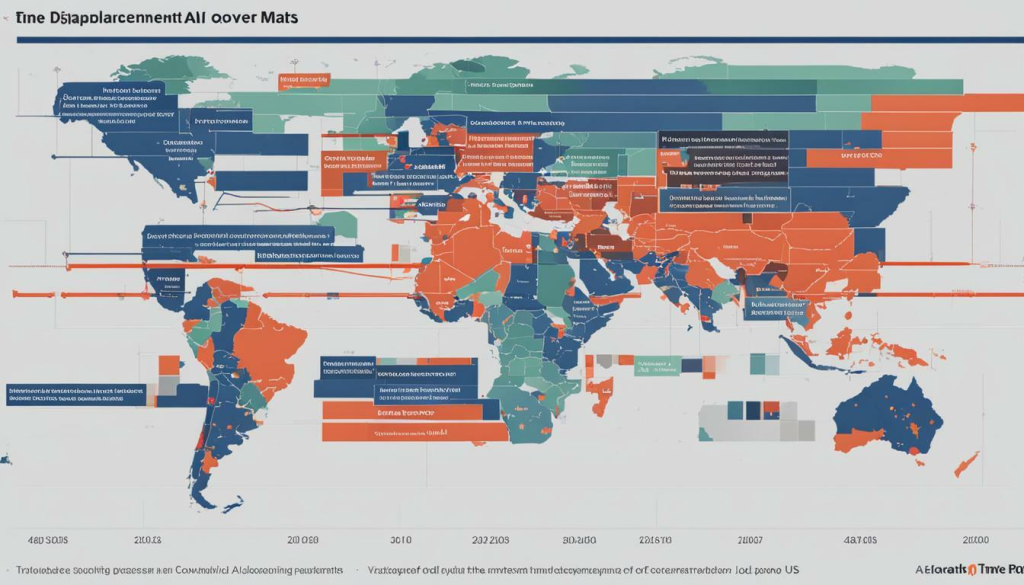
While the findings of these studies are still being analyzed, they highlight the need for proactive measures to ensure that AI’s impact on workforces is mitigated effectively. Policymakers, educators, and industry leaders can utilize these insights to develop strategies and policies that support workers and facilitate smooth transitions in the face of technological advancements. By understanding the implications of AI on workforces, governments, and organizations can collectively strive towards a future where technology and human workers coexist harmoniously.
Balancing Progress and Safeguards: Policymakers’ Dilemma
Policymakers face a challenging dilemma as they seek to harness the potential of AI technology for economic growth without compromising the well-being and livelihoods of workers. Advances in AI and automation have the potential to revolutionize industries, increase productivity, and drive innovation. However, there are concerns about the negative impact on employment and the displacement of jobs.
Studies have predicted that AI will result in job automation, leading to significant changes in the nature of work. While the extent of job displacement varies across industries and regions, it is crucial for policymakers to strike a balance between progress and safeguards that protect workers and consumers. This balancing act involves ensuring that the benefits of AI technology are distributed equitably while addressing the potential risks and challenges.
To achieve this balance, policymakers can implement various measures. Governments can conduct research to understand the implications of AI on employment, wages, and labor market opportunities. This research can inform targeted strategies that support workers affected by job displacement, such as job training and reskilling programs. Additionally, education systems need to be adapted to equip the workforce with the skills needed to thrive in an AI-driven future job market.
A robust welfare state plays a crucial role in mitigating the negative effects of automation. Welfare programs, including unemployment benefits, wage insurance, education subsidies, and career counseling, provide crucial support systems for workers affected by job displacement. The report also emphasizes the need for a more egalitarian society, where stability and minimum living standards are guaranteed for workers.
| Government Strategies | Supporting Workers | Building Egalitarian Societies |
|---|---|---|
| – Conduct research | – Job training and reskilling | – Welfare programs |
| – Implement targeted strategies | – Unemployment benefits | – Stability and minimum living standards |
| – Explore alternative income and taxation models | – Wage insurance |

“The impact of AI on workforces in the European Union and the United States is being studied to understand its implications for employment, wages, and labor market opportunities.” – AI Research Institute
Studying the Implications of AI on Workforces: EU and US Perspectives
- AI job market trends
- AI-driven job displacement
- Technology reshaping jobs
- AI employment effects
The ongoing studies in the European Union and the United States aim to provide valuable insights into the future of work in an AI-dominated era. By understanding the implications of AI on workforces, policymakers can make informed decisions and implement effective policies that balance progress and safeguards. It is crucial to foster an environment where AI technology can thrive while protecting the well-being and livelihoods of workers.
Through careful consideration and collaboration, policymakers can navigate the complex landscape of AI technology, ensuring that economic growth is accompanied by measures that support workers and promote a more equitable society. By striking a balance between progress and safeguards, policymakers can shape the future of work in a way that benefits both the economy and the workforce.
References
- “The Future of Work.” AI Research Institute. Retrieved from www.airesearch.org/future-of-work
The Potential of AI to Automate Tasks: Opportunities and Risks
AI has the potential to revolutionize the job market by automating a wide range of tasks, from repetitive routines to complex decision-making processes, creating both opportunities and risks for workers. As AI technology advances, it can take over mundane, time-consuming tasks, allowing employees to focus on higher-value work that requires creativity and critical thinking.
However, this automation also poses risks to certain job roles. Routine tasks that can be easily automated, such as data entry or basic customer service, may be replaced by AI systems. As a result, workers in these positions may face job displacement or the need to upskill in order to stay relevant in the evolving job market.
| Opportunities of AI Automation | Risks of AI Automation |
|---|---|
| 1. Increased efficiency and productivity 2. Ability to handle large volumes of data 3. Improved accuracy and precision 4. Enhanced customer service through chatbots and virtual assistants | 1. Job displacement in certain industries and roles 2. Skills gaps and the need for upskilling 3. Concerns about job quality and stability 4. Potential bias and ethical considerations in AI decision-making |
While AI automation presents both opportunities and risks, it is crucial for policymakers and organizations to find the right balance. This involves implementing safeguards and support systems to mitigate the negative effects of job displacement and ensure workers are equipped with the skills needed to thrive in the evolving workforce.
Machine Learning and Workforce Transformation
Machine learning, a subset of AI, plays a vital role in workforce transformation. It enables systems to learn from data and make predictions or decisions without explicit programming. This technology has the potential to significantly impact various industries, including healthcare, finance, and manufacturing.
“Machine learning algorithms can analyze vast amounts of medical data to assist in diagnosis, predict financial market trends, and optimize manufacturing processes. However, it is important to address the ethical concerns surrounding data privacy, security, and transparency in AI-driven decision-making.”
As AI continues to evolve, it is essential for policymakers, organizations, and individuals to adapt and embrace change. Building a future workforce that can thrive in collaboration with AI technologies requires a combination of reskilling, upskilling, and a proactive approach to embrace new opportunities.
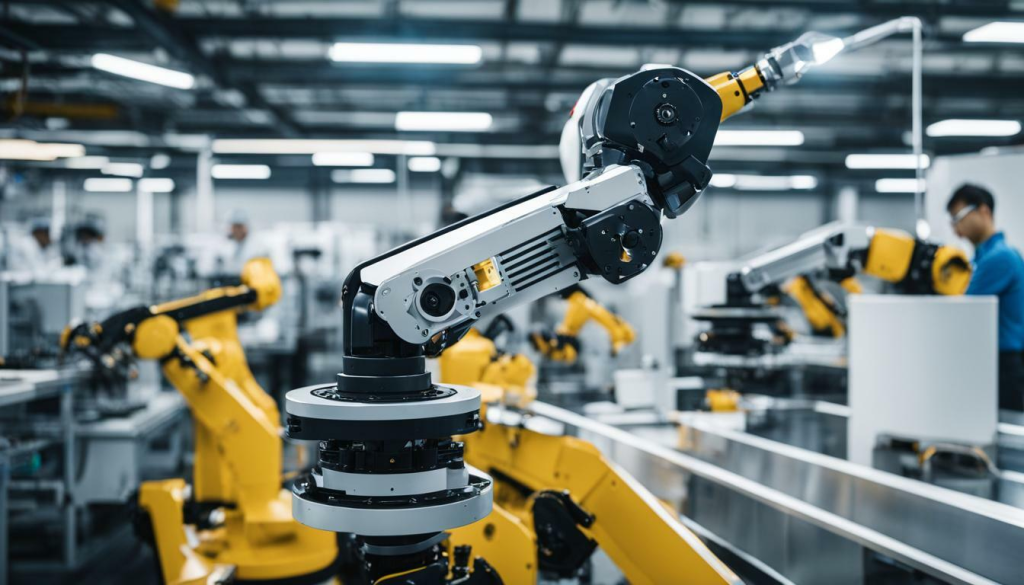
Overall, the potential of AI to automate tasks presents significant opportunities for increased efficiency and productivity. However, it also poses risks of job displacement and the need for skills development. By finding the right balance, we can harness the transformative power of AI while ensuring a workforce that is prepared for the future.
Adapting Education Systems: Equipping the Workforce for the Future
As AI and automation reshape the job market, adapting education systems becomes crucial to ensure that workers possess the skills necessary to succeed in the evolving landscape of work. The impact of AI on jobs and the nature of work requires a proactive approach to equip the workforce with the knowledge and abilities that align with emerging job demands.
Current education systems need to be re-evaluated to address the skills gap and prepare individuals for the future of work. This involves integrating technology into classrooms, fostering digital literacy, and prioritizing STEM (Science, Technology, Engineering, and Mathematics) education. By equipping students with these foundational skills, we enable them to navigate the complex and technologically advanced workplaces of tomorrow.
Reskilling and upskilling initiatives are essential to ensure that existing workers are not left behind as automation advances. Employers, policymakers, and educational institutions need to collaborate to provide accessible and affordable training programs that enable workers to adapt to new technologies and acquire in-demand skills. Continued education throughout one’s career will become increasingly important as job requirements evolve in response to AI and automation.
| Ways to adapt education systems: | Key benefits: |
|---|---|
| Integrate technology into classrooms | Enhanced digital literacy and familiarity with AI technologies |
| Prioritize STEM education | Increase the number of qualified professionals in high-demand fields |
| Implement reskilling and upskilling programs | Address skills gap and keep workers competitive in the job market |
| Collaborate with employers and policymakers | Create relevant and accessible training opportunities |
“Education is the most powerful weapon which you can use to change the world.” – Nelson Mandela
The Role of Vocational Education
Vocational education plays a crucial role in preparing individuals for specific fields and occupations. By offering specialized training and industry-specific certifications, vocational education equips students with practical skills that align with the needs of the job market. As AI and automation reshape jobs, expanding and modernizing vocational programs can ensure a skilled and adaptable workforce.

By embracing continuous learning, integrating technology into classrooms, and focusing on reskilling and upskilling, education systems can effectively equip the workforce for the future. It is essential to recognize that the future of work will require individuals to possess a combination of technical proficiency, critical thinking, creativity, and adaptability. By fostering these qualities through education, we can empower individuals to thrive in the face of automation and job displacement, creating a more resilient and prosperous workforce.
Striking a Balance: Progress, Innovation, and Worker Safeguards
Striking a balance between progress and worker safeguards is vital to harness the potential of AI while minimizing the disruption caused by job displacement and technological unemployment. Factual data indicates that advances in artificial intelligence and automation have raised concerns about the impact on employment. Studies have predicted significant changes in the nature of work, with high levels of job automation expected in various industries and geographic regions. In the UK, for example, former industrial areas face higher levels of job automation, with 30% of jobs at high risk.
Governments play a crucial role in mitigating the negative effects of automation by implementing targeted strategies. This includes conducting research, adapting education systems, and exploring alternative income and taxation models. Welfare programs, such as unemployment benefits, wage insurance, job training and reskilling, education subsidies, and career counseling, provide crucial support to workers affected by job displacement.
Creating a more egalitarian society with a robust welfare state is necessary to ensure stability and minimum living standards for workers. Additionally, ongoing studies in the European Union and the United States are examining the implications of AI on workforces, including employment, wages, and labor market opportunities. AI has the potential to automate both routine and non-routine tasks, presenting both opportunities and risks. Policymakers must strike a balance between progress, innovation, and implementing safeguards to address the potential negative impact of AI on jobs.
| Welfare Programs | Benefits |
|---|---|
| Unemployment Benefits | Financial assistance for workers who have lost their jobs due to automation |
| Wage Insurance | Temporary financial support to bridge the gap between old and new jobs with reduced wages |
| Job Training and Reskilling | Programs to equip workers with skills needed for new job opportunities in the AI era |
| Education Subsidies | Financial assistance for workers seeking further education or retraining |
| Career Counseling | Guidance and support to help workers navigate the changing job market |
“The potential of AI to automate tasks is immense, but we must ensure that progress is accompanied by safeguards for workers and consumers.”
Adapting Education Systems: Equipping the Workforce for the Future
In order to thrive in a future shaped by AI and automation, it is crucial to adapt education systems and equip the workforce with the necessary skills. This includes incorporating technology-driven subjects into curricula, promoting lifelong learning, and fostering a culture of innovation and adaptability. By bridging the gap between the skills demanded by the job market and those offered by educational institutions, workers can stay competitive and navigate the changing landscape of work.
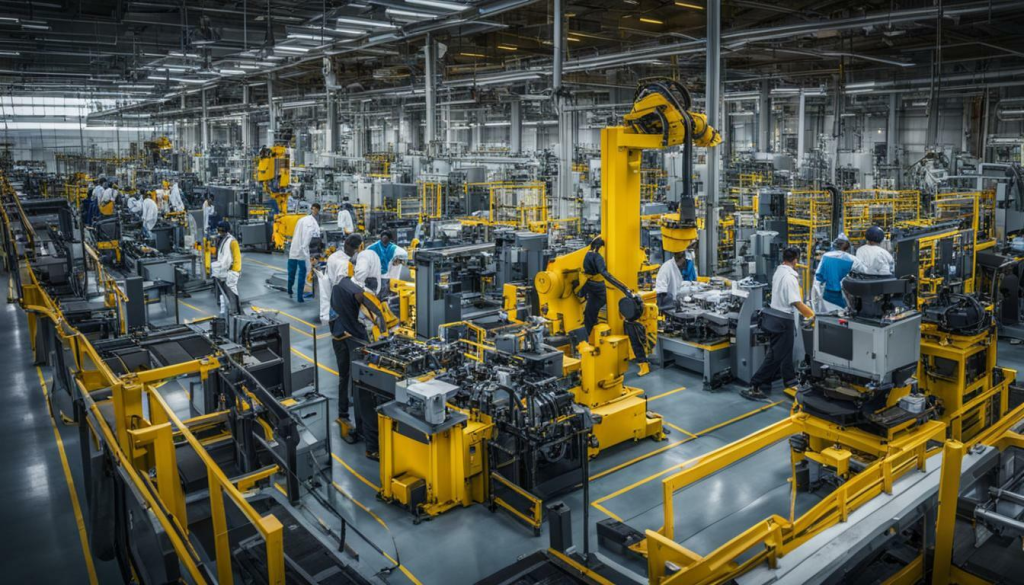
Striking a balance between progress, innovation, and worker safeguards is a complex challenge that requires collaboration between policymakers, industry stakeholders, and society as a whole. By harnessing the potential of AI while implementing necessary safeguards, we can navigate the changes brought about by technological advancements and ensure a future where both workers and consumers thrive.
Understanding the Future Job Market: AI and Beyond
The future job market will undoubtedly be shaped by AI and automation, impacting employment opportunities and requiring a reevaluation of workforce dynamics. As advancements in artificial intelligence continue to reshape industries, it is crucial to explore the potential implications on employment and prepare for the changes that lie ahead.
According to studies, job automation is expected to vary across different industries and geographic regions. In the United Kingdom, for instance, approximately 30% of jobs are at high risk of automation, with former industrial areas facing even higher levels of risk. This highlights the need for policymakers and stakeholders to address these disparities and implement targeted strategies to mitigate the negative effects of automation.
Government intervention plays a vital role in preparing the workforce for the future. By conducting research, policymakers can gain valuable insights into the impact of AI on employment, wages, and labor market opportunities. This knowledge can then be utilized to adapt education systems and equip workers with the skills needed to thrive in an AI-driven world. Additionally, exploring alternative income and taxation models can ensure economic stability and empower individuals in the face of job displacement.
Welfare programs are essential support systems for workers affected by job displacement. Unemployment benefits, wage insurance, job training and reskilling, education subsidies, and career counseling all play a crucial role in helping individuals navigate the challenges brought on by AI and automation. Furthermore, building a more egalitarian society with a robust welfare state is crucial to ensure stability and minimum living standards for all workers.

The implications of AI and automation on workforces are being extensively studied in both the European Union and the United States. These studies aim to deepen our understanding of the evolving employment landscape and identify potential challenges and opportunities. By analyzing the data and insights gathered, policymakers can make informed decisions to safeguard workers and consumers while fostering innovation and progress.
The potential of AI to automate routine and non-routine tasks is both remarkable and daunting. While it opens up opportunities for increased efficiency and productivity, it also poses risks such as job displacement. Striking a balance between progress and safeguards is essential to ensure that the benefits of AI and automation are shared by all and promote a thriving and inclusive workforce.
In conclusion, as the future job market continues to evolve, AI and automation have become significant drivers of change. Adapting to this new reality requires a collaborative effort from governments, policymakers, and stakeholders to address the challenges and opportunities presented. By embracing technological advancements while prioritizing worker protection and inclusivity, we can shape a future job market that harnesses the transformative power of AI while ensuring the well-being and prosperity of all individuals.
Conclusion
In conclusion, AI job displacement is a growing phenomenon with varying impacts across industries and regions, necessitating comprehensive solutions and strategies to navigate the evolving landscape of work. Advances in artificial intelligence (AI) and automation have raised concerns about job displacement, as studies predict high levels of job automation and significant changes in the nature of work.
However, governments can play a crucial role in mitigating the negative effects of automation. By conducting research, implementing targeted strategies, and adapting education systems, they can help equip the workforce with the necessary skills to thrive in an AI-driven future. Furthermore, exploring alternative income and taxation models can provide additional support to workers affected by job displacement.
AI has the potential to automate routine and non-routine tasks, presenting both opportunities and risks for the workforce. Therefore, policies should be designed to harness the benefits of AI while safeguarding the interests of workers.
Discover the future of well-being! Explore our blog for captivating insights at the intersection of health and technology. Your journey to a healthier, tech-enhanced life begins now
FAQ
Q: Are all jobs at risk of automation?
A: No, the impact of automation varies across industries and geographic regions. Some jobs are more susceptible to automation than others.
Q: What steps can governments take to mitigate the negative effects of automation?
A: Governments can conduct research, implement targeted strategies, adapt education systems, and explore alternative income and taxation models.
Q: How can welfare programs support workers affected by job displacement?
A: Welfare programs such as unemployment benefits, wage insurance, job training and reskilling, education subsidies, and career counseling can provide crucial support to workers affected by job displacement.
Q: What is the role of a robust welfare state in ensuring stability and minimum living standards?
A: A more egalitarian society with a robust welfare state can ensure stability and minimum living standards for workers in the face of automation.
Q: What ongoing studies are exploring the implications of AI on workforces?
A: Ongoing studies in the European Union and the United States are examining the implications of AI on employment, wages, and labor market opportunities.
Q: How can policymakers balance progress and innovation with safeguards for workers and consumers?
A: Policymakers must strike a balance between progress and innovation in AI technology while implementing safeguards for both workers and consumers.
Q: What tasks can AI potentially automate?
A: AI has the potential to automate both routine and non-routine tasks in various industries.
Q: Why is it important to adapt education systems in the face of AI and automation?
A: Adapting education systems is crucial to equip the workforce with the skills needed to thrive in a future where AI and automation play a significant role.
Q: How can policymakers address the potential negative impact of AI on jobs?
A: Policymakers and stakeholders must strike a balance between progress, innovation, and implementing safeguards to address the potential negative impact of AI on jobs.
Q: What does the future job market look like with the rise of AI?
A: The future job market is expected to undergo significant changes with the impact of AI and automation on employment and workforce dynamics.

